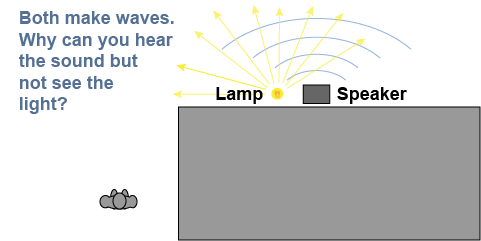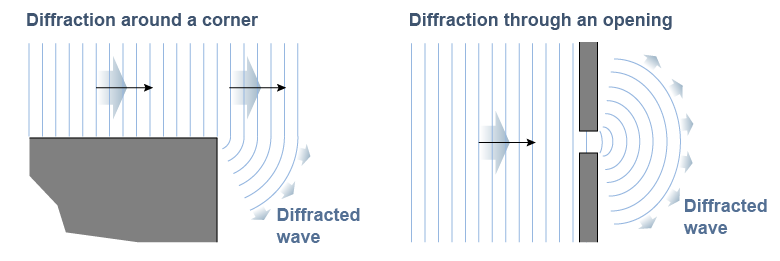|
 Sound and light are both waves, but they behave differently when they encounter obstacles. Consider a speaker and a lamp behind a corner. You cannot see the lamp but you can hear the sound! Why? Why does a sound wave bend around a corner but a light wave does not!
Sound and light are both waves, but they behave differently when they encounter obstacles. Consider a speaker and a lamp behind a corner. You cannot see the lamp but you can hear the sound! Why? Why does a sound wave bend around a corner but a light wave does not!

|
The answer is diffraction. Diffraction is a property of waves that allows a wave to bend around an obstacle, such as a corner. Sound waves diffract around the corner because the wavelength of sound is typically a few centimeters. This wavelength is comparable to the size of the corner itself. Light waves also diffract slightly around the corner but the typical wavelength of a light wave is on the order of 10−5 cm. This is far smaller than the scale of the corner itself, and the amount of diffraction is imperceptible.

|

|
Diffraction often changes the direction and shape of a wave. A plane wave passing a corner is diffracted so that its wavefronts become nearly circular at the edges. The same plane wave passing through a slot spreads out into a circular wave on the other side of the slot. Diffraction of sound explains why you can hear someone in another room even if the door is open only a crack. Diffraction causes a sound wave to spread out from the crack. This also occurs for light waves but you typically have to look at fairly small systems or very fine details to see the effects of diffraction of light. 
|
Diffraction has many implications for technology. Radio waves have wavelengths that can be tens of meters to kilometers long. This allows radio signals to bend around obstacles such as mountains. Cellphone transmissions, in contrast, use much shorter wavelengths, typically 6–12 cm. As a result, cellphone waves diffract (spread) less, which is why good reception typically requires a direct line of sight from the phone to the nearest tower. 
|

